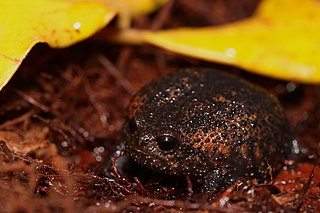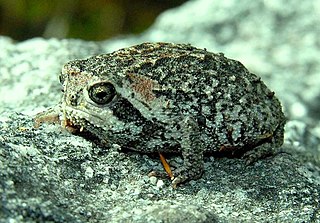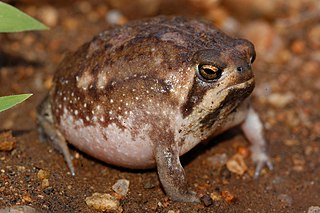
A tadpole is the larval stage in the biological life cycle of an amphibian. Most tadpoles are fully aquatic, though some species of amphibians have tadpoles that are terrestrial. Tadpoles have some fish-like features that may not be found in adult amphibians such as a lateral line, gills and swimming tails. As they undergo metamorphosis, they start to develop functional lungs for breathing air, and the diet of tadpoles changes drastically.

Probreviceps is a small genus of brevicipitine frogs with only six members. They occur in the montane forests of Tanzania, Zimbabwe, and possibly Mozambique. They are sometimes known as the forest frogs, forest rain frogs, big-fingered frogs, or primitive rain frogs.

Hyperolius is a large genus of frogs in the family Hyperoliidae from Sub-Saharan Africa.

Breviceps acutirostris, also known as common rain frog, strawberry rain frog, or Cape short-headed frog, is a species of frog in the family Brevicipitidae. It is endemic to the southwestern Cape region in South Africa. It is a burrowing frog that lives in fynbos heatland and forests at elevations below 1,600 m (5,200 ft) above sea level. Development is direct . It is threatened by habitat loss, although much of its habitat is also protected.

Bilbo's rain frog is an amphibian species in the family Brevicipitidae, endemic to South Africa. The frog was named after Bilbo Baggins, the main character from The Hobbit by J.R.R Tolkien. The frog was named as such because the scientist who discovered it used to read the novel to his children. Its natural habitats are temperate grasslands and edges of wood plantations, wherein it spends most of its time in its burrow. The species is threatened by construction, maintenance of roads, silviculture, general habitat degradation/habitat loss, and by road traffic. As a result, it is listed as Near Threatened in the IUCN Red List of Threatened Species.

Breviceps fuscus, also known as black rain frog, plain rain frog, brown short-headed frog, and Tsitsikamma rainfrog, is a species of frogs in the family Brevicipitidae. It is endemic to the southern coast of South Africa.

The cape rain frog or giant rain frog is a species of frog in the family Brevicipitidae. Adults grow up to 45 mm in length. It was the first African frog species to be scientifically described by Carl Linnaeus in 1758, under the name Rana gibbosa. It is the most common and largest of rain frogs. The name "rain frog" that is applied to the genus refers to a belief that these frogs bring rain.

The desert rain frog, web-footed rain frog, or Boulenger's short-headed frog is a species of frog in the family Brevicipitidae. It is found in Namibia and South Africa. Its natural habitat is the narrow strip of sandy shores between the sea and the sand dunes. It is threatened by habitat loss by such factors as mining and tourism.

The mountain rain frog is a species of frogs in the family Brevicipitidae.

The Mozambique rain frog, also known as the flat-faced frog, is a species of frog in the family Brevicipitidae. It is found in Botswana, Democratic Republic of the Congo, Eswatini, Malawi, Mozambique, South Africa, Tanzania, Zambia, Zimbabwe, and possibly Lesotho. Its natural habitats are dry savanna, moist savanna, temperate shrubland, subtropical or tropical dry shrubland, temperate grassland, subtropical or tropical dry lowland grassland, subtropical or tropical high-altitude grassland, arable land, pasture land and rural gardens.

The Namaqua rain frog or Namaqua short-headed frog is a species of frogs in the family Brevicipitidae. It is found in Namaqualand in western South Africa and extreme southern Namibia.

Rose's rain frog or Rose's rainfrog is a species of frog in the family Brevicipitidae. It is endemic to the sandveld of south-western coastal South Africa. It is less-frequently known as Rose's short-headed frog, Rose's Blaasop, or the sand rain frog. Some treat Breviceps fasciatus as a synonym of this species, although other authorities have expressed doubt.

The forest rain frog is a species of frog in the family Brevicipitidae. It is endemic to Limpopo, South Africa. Two allopatric subspecies are recognized: the nominate one, Breviceps sylvestris sylvestris, and Breviceps sylvestris taeniatusPoynton, 1963 from near Soutpansberg. Its natural habitats are temperate forests, temperate grassland, and rural gardens. It is threatened by habitat loss.

Phrynobatrachus is a genus of Sub-Saharan frogs that form the monogeneric family Phrynobatrachidae. Their common name is puddle frogs, dwarf puddle frogs, African puddle frogs, or African river frogs. The common name, puddle frog, refers to the fact that many species breed in temporary waterbodies such as puddles.

Brevicipitidae or rain frogs is a small family of frogs found in eastern and southern Africa. As of 2020 contains 37 species in 5 genera. Formerly included as subfamily in Microhylidae, phylogenetic research has indicated the brevicipitine frogs should be considered as a family with Hemisotidae as the most closely related sister taxon.
Common rain frog may refer to:

Breviceps carruthersi or the Phinda rain frog or Carruthers' rain frog is a species of frog in the Breviceps genus endemic to South Africa. The Phinda rain frog is also known as Isinana sakwaPhinda in IsiZulu which is the local language spoken in this species' native range. An IsiZulu description of this anuran amphibian species appears in a field guide called A Bilingual Guide to the Frogs of Zululand. This frog was first described by Professor Louis H. du Preez, Doctor Edward C. Netherlands, and Professor Les Minter in 2017, and they named it in honour of the naturalist and author Vincent Caruthers.
Breviceps branchi or Branch's rain frog is a species of frogs endemic to South Africa in the Breviceps genus of frogs.

Breviceps passmorei, or Passmore's rain frog or Ndumo rain frog is a species of frog in the genus Breviceps endemic to South Africa.
















